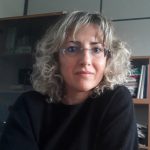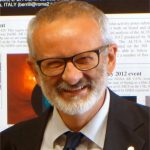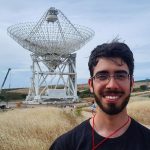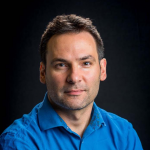 Dr. Francesca Altieri is researcher at INAF/IAPS in Rome since 2006. She studies the surface composition of solid bodies of the Solar System and phenomena linked to planetary atmospheres. Involved in most of the current and forthcoming planetary space missions, she is Co-I of OMEGA-MEX, NOMAD-TGO, VIHI-Bepi-Colombo, and MAJIS-JUICE, Team Member of JIRAM-JUNO, member of ARIEL team. As Deputy-PI of the Ma_MISS instrument, the miniaturized spectrometer in the Drill System of the first ESA Rover (ExoMars2020), she will investigate the martian sub-surface to search for traces of past or present life signatures on Mars.
Dr. Francesca Altieri is researcher at INAF/IAPS in Rome since 2006. She studies the surface composition of solid bodies of the Solar System and phenomena linked to planetary atmospheres. Involved in most of the current and forthcoming planetary space missions, she is Co-I of OMEGA-MEX, NOMAD-TGO, VIHI-Bepi-Colombo, and MAJIS-JUICE, Team Member of JIRAM-JUNO, member of ARIEL team. As Deputy-PI of the Ma_MISS instrument, the miniaturized spectrometer in the Drill System of the first ESA Rover (ExoMars2020), she will investigate the martian sub-surface to search for traces of past or present life signatures on Mars.
 Prof. Amedeo Balbi is associate professor of astronomy and astrophysics at the Physics Dept. of the University of Rome “Tor Vergata”. He is the author or co-author of over 90 scientific papers, spanning a broad set of topics, including the physics of the early universe, the problem of dark matter and energy, and the search for life in the cosmos. His current research interests include theoretical studies of habitability and understanding the emergence of complexity and the distribution of life in the universe. He is a member of the Scientific Council of the Italian Society of Astrobiology.
Prof. Amedeo Balbi is associate professor of astronomy and astrophysics at the Physics Dept. of the University of Rome “Tor Vergata”. He is the author or co-author of over 90 scientific papers, spanning a broad set of topics, including the physics of the early universe, the problem of dark matter and energy, and the search for life in the cosmos. His current research interests include theoretical studies of habitability and understanding the emergence of complexity and the distribution of life in the universe. He is a member of the Scientific Council of the Italian Society of Astrobiology.
 Prof. Francesco Berrilli is professor of Computational Physics and Solar and Space Physics at the University of Rome “Tor Vergata” and member of Lyncean National Academy. He began his astrophysical career working on of infrared astronomy and star formation. He has been involved in the design and development of various focal plane instruments for space and ground-based projects. He is currently involved in the European Solar Telescope project, the synoptic MOF-based telescope network, including the South Pole Solar Observatory, and in the investigation of spectroscopic properties of exoplanets and their climate.
Prof. Francesco Berrilli is professor of Computational Physics and Solar and Space Physics at the University of Rome “Tor Vergata” and member of Lyncean National Academy. He began his astrophysical career working on of infrared astronomy and star formation. He has been involved in the design and development of various focal plane instruments for space and ground-based projects. He is currently involved in the European Solar Telescope project, the synoptic MOF-based telescope network, including the South Pole Solar Observatory, and in the investigation of spectroscopic properties of exoplanets and their climate.
 Prof. Daniela Billi is associate professor at the University of Rome “Tor Vergata”, Dept Biology where she is leading the Laboratory of Astrobiology and Molecular Biology of Cyanobacteria. She is interested in the survival thresholds and adaptive responses of extreme-tolerant cyanobacteria under space conditions and planetary simulations. She is co-chair of the ESA TT-Astrobiology, President of the Scientific Committee of SIA, member of the ASI astrobiology-working group and of the executive council of EANA. Currently she is PI of ASI- and PNRA-funded grants.
Prof. Daniela Billi is associate professor at the University of Rome “Tor Vergata”, Dept Biology where she is leading the Laboratory of Astrobiology and Molecular Biology of Cyanobacteria. She is interested in the survival thresholds and adaptive responses of extreme-tolerant cyanobacteria under space conditions and planetary simulations. She is co-chair of the ESA TT-Astrobiology, President of the Scientific Committee of SIA, member of the ASI astrobiology-working group and of the executive council of EANA. Currently she is PI of ASI- and PNRA-funded grants.
 Dr. Chiara Cagnazzo is scientist at the Institute of Atmosphere and Climate (ISAC) of the National Research Council (CNR) in Rome. Her research activity covers different topics, including climate variability and changes, Earth and atmospheric numerical modeling, climate dynamics and predictability. Since 2012 she is responsible of the Numerical Modeling Course at the University of Rome “Tor Vergata”. Her current research interests include the study of exo-planets climates through the use of General Circulation Models. She is Review Editor of the 2018 WMO/UNEP Scientific Assessment of Ozone Depletion.
Dr. Chiara Cagnazzo is scientist at the Institute of Atmosphere and Climate (ISAC) of the National Research Council (CNR) in Rome. Her research activity covers different topics, including climate variability and changes, Earth and atmospheric numerical modeling, climate dynamics and predictability. Since 2012 she is responsible of the Numerical Modeling Course at the University of Rome “Tor Vergata”. Her current research interests include the study of exo-planets climates through the use of General Circulation Models. She is Review Editor of the 2018 WMO/UNEP Scientific Assessment of Ozone Depletion.
 Dr. Dario Del Moro is assistant professor at the Physics Dept. in the University of Rome “Tor Vergata” since 2008. He has worked on a number of research topics in Solar Physics, Earth and Planetary Sciences, and Applied Optics: Dynamics of the lower solar atmosphere (photosphere and chromosphere); Organization of plasma and magnetic field structures in the solar photosphere; Coronal Mass Ejection propagation; Data Analysis; Adaptive Optics systems; Optical instrumentation.
Dr. Dario Del Moro is assistant professor at the Physics Dept. in the University of Rome “Tor Vergata” since 2008. He has worked on a number of research topics in Solar Physics, Earth and Planetary Sciences, and Applied Optics: Dynamics of the lower solar atmosphere (photosphere and chromosphere); Organization of plasma and magnetic field structures in the solar photosphere; Coronal Mass Ejection propagation; Data Analysis; Adaptive Optics systems; Optical instrumentation.
 Dr. Maria Pia Di Mauro is researcher astronomer at INAF/IAPS in Rome, with main interests in solar and stellar structure and evolution. Expert in Helio- and Asteroseismology, she uses stellar oscillations to characterize the stars and the exoplanets they might host. She is the PI of HELAS, the European Network in Helio- and Asteroseismology and member of TASC, the TESS (NASA) Asteroseismic Science Consortium, of the scientific team of PLATO 2.0/ESA space mission, of the Kepler/NASA Asteroseismic Science Consortium; participates in GAPS, the Italian project to investigate in the field of exoplanetary science by observing with HARPS-N.
Dr. Maria Pia Di Mauro is researcher astronomer at INAF/IAPS in Rome, with main interests in solar and stellar structure and evolution. Expert in Helio- and Asteroseismology, she uses stellar oscillations to characterize the stars and the exoplanets they might host. She is the PI of HELAS, the European Network in Helio- and Asteroseismology and member of TASC, the TESS (NASA) Asteroseismic Science Consortium, of the scientific team of PLATO 2.0/ESA space mission, of the Kepler/NASA Asteroseismic Science Consortium; participates in GAPS, the Italian project to investigate in the field of exoplanetary science by observing with HARPS-N.
 Dr. Daniele Galuzzo is a Ph.D. student in Astronomy, Astrophysics and Space Science at the University of Rome “Tor Vergata”. He formed in the field of Earth’s atmospheric physics and climate, with particular attention to the sea-ice climatology and its variability in Antarctica. He works on numerical simulation of exoplanets’ atmospheres, using 3-D General Circulation Models. His current research regards the study of the atmospheric dynamics and climate of exotic Earth-like worlds, to evaluate the habitability conditions and the radiative properties of such atmospheres, in order to establish the observation limits in the case of existing planets.
Dr. Daniele Galuzzo is a Ph.D. student in Astronomy, Astrophysics and Space Science at the University of Rome “Tor Vergata”. He formed in the field of Earth’s atmospheric physics and climate, with particular attention to the sea-ice climatology and its variability in Antarctica. He works on numerical simulation of exoplanets’ atmospheres, using 3-D General Circulation Models. His current research regards the study of the atmospheric dynamics and climate of exotic Earth-like worlds, to evaluate the habitability conditions and the radiative properties of such atmospheres, in order to establish the observation limits in the case of existing planets.
 Dr. Luca Giovannelli is assistant professor at the Physics Dept. in the University of Rome “Tor Vergata”, teaching Laboratory of Astrophysics and Foundations of Physics Education. He is specialized in the design and manifacture of instrumentation for high resolution spectroscopic observations. His interests span from the Sun-Earth interaction, to spaceweather and spaceclimate, active magnetic stars influence on exoplanetary systems and earthlike exoplanets atmosphere characterization. He is involved in the European Solar Telescope projectand in several scientific dissemination projects.
Dr. Luca Giovannelli is assistant professor at the Physics Dept. in the University of Rome “Tor Vergata”, teaching Laboratory of Astrophysics and Foundations of Physics Education. He is specialized in the design and manifacture of instrumentation for high resolution spectroscopic observations. His interests span from the Sun-Earth interaction, to spaceweather and spaceclimate, active magnetic stars influence on exoplanetary systems and earthlike exoplanets atmosphere characterization. He is involved in the European Solar Telescope projectand in several scientific dissemination projects.
 Dr. Stavro Ivanovski is a research scientist at INAF/OATS. In INAF/IAPS, Rome he worked on many planetology projects and space science missions for the Solar System. His expertise includes numerical modeling in: dust dynamics in cometary atmosphere and protoplanetary discs, MHD instabilities at magnetospheres of Earth and Mercury, and magnetoconvection simulations of sunspots. He is Co-I of GIADA/Rosetta, Team member of BepiColombo/SERENA, SPICA, and LICIACube projects. Since January 2018 he is member of the habitability working group at the Observatory of Trieste.
Dr. Stavro Ivanovski is a research scientist at INAF/OATS. In INAF/IAPS, Rome he worked on many planetology projects and space science missions for the Solar System. His expertise includes numerical modeling in: dust dynamics in cometary atmosphere and protoplanetary discs, MHD instabilities at magnetospheres of Earth and Mercury, and magnetoconvection simulations of sunspots. He is Co-I of GIADA/Rosetta, Team member of BepiColombo/SERENA, SPICA, and LICIACube projects. Since January 2018 he is member of the habitability working group at the Observatory of Trieste.
 Prof. Ugo Locatelli is associate professor of Mathematical Physics at the Mathematics Dept. of the Univ. of Rome “Tor Vergata”. He is chair of the scientific council of the SIMCA (Italian Society of Celestial Mechanics and Astrodynamics). He is chair of the commission ruling the computational resources of the Math. Dept. His research activity is based on perturbative methods for Hamiltonian quasi-integrable systems. This approach allowed him to study the orbital stability into the light of KAM theory. He is working on the applications of the stability concept so to infer some astronomical properties of exoplanets.
Prof. Ugo Locatelli is associate professor of Mathematical Physics at the Mathematics Dept. of the Univ. of Rome “Tor Vergata”. He is chair of the scientific council of the SIMCA (Italian Society of Celestial Mechanics and Astrodynamics). He is chair of the commission ruling the computational resources of the Math. Dept. His research activity is based on perturbative methods for Hamiltonian quasi-integrable systems. This approach allowed him to study the orbital stability into the light of KAM theory. He is working on the applications of the stability concept so to infer some astronomical properties of exoplanets.
 Dr. Luigi Mancini is a research scientist at the Physics Dept. of the University of Rome “Tor Vergata”. He is also affiliated at the Max Planck Institute for Astronomy in Heidelberg and at the INAF Astrophysical Observatory of Turin. His current research is focused on the search for Extrasolar Planets and their characterization. He is involved in several collaborations, including HATSouth, which uses a network of automated wide field telescopes, for detecting new transiting exoplanets, and GAPS, which is undertaking a challenging observational program to characterize the global architectural properties of exoplanetary systems.
Dr. Luigi Mancini is a research scientist at the Physics Dept. of the University of Rome “Tor Vergata”. He is also affiliated at the Max Planck Institute for Astronomy in Heidelberg and at the INAF Astrophysical Observatory of Turin. His current research is focused on the search for Extrasolar Planets and their characterization. He is involved in several collaborations, including HATSouth, which uses a network of automated wide field telescopes, for detecting new transiting exoplanets, and GAPS, which is undertaking a challenging observational program to characterize the global architectural properties of exoplanetary systems.
 Dr. Anna Milillo is researcher at INAF/IAPS in Rome since 1999. She studies the interaction of space environment with Solar System bodies, starting from Earth’s exosphere and magnetosphere, but also investigating interactions between the ions and radiation with upper atmospheres/exospheres/
Dr. Anna Milillo is researcher at INAF/IAPS in Rome since 1999. She studies the interaction of space environment with Solar System bodies, starting from Earth’s exosphere and magnetosphere, but also investigating interactions between the ions and radiation with upper atmospheres/exospheres/
 Dr. Alessandro Mura is researcher at INAF/IAPS in Rome since 2003. Among his interests is the interaction between stellar wind and solar and extra-solar system bodies. In recent years, he studied the formation of Mercury exosphere and the interaction of Mars and Venus environments with the solar wind. He has been Co-I in BepiColombo/SERENA, and PI of the RAMON instrument on board the proposed M3 ESA mission “MarcoPolo”, devoted to the study of the interaction between the solar wind and a near-earth object. Currently, he is Deputy-PI of JUNO/JIRAM and member of the ARIEL team for the ESA M4 mission proposal.
Dr. Alessandro Mura is researcher at INAF/IAPS in Rome since 2003. Among his interests is the interaction between stellar wind and solar and extra-solar system bodies. In recent years, he studied the formation of Mercury exosphere and the interaction of Mars and Venus environments with the solar wind. He has been Co-I in BepiColombo/SERENA, and PI of the RAMON instrument on board the proposed M3 ESA mission “MarcoPolo”, devoted to the study of the interaction between the solar wind and a near-earth object. Currently, he is Deputy-PI of JUNO/JIRAM and member of the ARIEL team for the ESA M4 mission proposal.
 Dr. Giuseppe Piccioni is director of research at INAF-IAPS in Rome. Since the 90’s he was involved in several space missions for the Solar System, from design to calibration and data analysis. Among those, Co-I of PFS-Mars Express, PI of VIRTIS-Venus Express, Co-I of VIRTIS-ROSETTA, PI of the proposal of MAJIS selected for JUICE, WG leader of the “Sistema solare e simulazioni di laboratorio” for the “Premiale INAF WOW” (“a Way to Other Worlds”). Presently he is Co-PI of MAJIS-JUICE, Team Member of JIRAM-JUNO, Co-I of VIHI-Bepi-Colombo and member of ARIEL team. He is also leading the laboratory activities at IAPS-PLAB.
Dr. Giuseppe Piccioni is director of research at INAF-IAPS in Rome. Since the 90’s he was involved in several space missions for the Solar System, from design to calibration and data analysis. Among those, Co-I of PFS-Mars Express, PI of VIRTIS-Venus Express, Co-I of VIRTIS-ROSETTA, PI of the proposal of MAJIS selected for JUICE, WG leader of the “Sistema solare e simulazioni di laboratorio” for the “Premiale INAF WOW” (“a Way to Other Worlds”). Presently he is Co-PI of MAJIS-JUICE, Team Member of JIRAM-JUNO, Co-I of VIHI-Bepi-Colombo and member of ARIEL team. He is also leading the laboratory activities at IAPS-PLAB.

Dr. Francesco Tombesi is a “Montalcini” assistant professor at the Dept. of Physics of the University of Rome “Tor Vergata”. He is also affiliated at the INAF – Astronomical Observatory of Rome, NASA – Goddard Space Flight Center (USA), and the University of Maryland, College Park (USA). He studies the accretion and ejection phenomena onto supermassive black holes at the center of active galaxies through X-ray observations and the feedback of black hole winds on galaxy evolution. His research was the cover story of the March 2015 edition of Nature. He was awarded the 2016 NASA “Exceptional Scientific Achievement Medal”.
